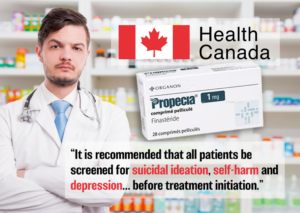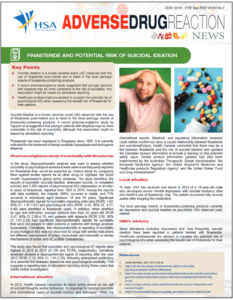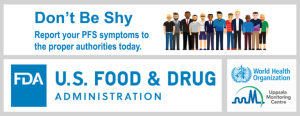Jan. 28, 2024
Dear Friends:
Canada is taking no chances vis-á-vis finasteride wreaking havoc on its citizens’ psyches.
Pre-prescription edict
 Last week, drug-regulatory authority (DRA) Health Canada (HC), via its monthly Health Product InfoWatch bulletin, informed its nation’s healthcare professionals that:
Last week, drug-regulatory authority (DRA) Health Canada (HC), via its monthly Health Product InfoWatch bulletin, informed its nation’s healthcare professionals that:
The Warnings and Precautions and Patient Medication Information sections of the Canadian product monographs [aka, labels] for Propecia and Proscar have been updated with the risk of mood alterations.
HC goes on to highlight key messages, including:
• There have been post-marketing reports of serious psychiatric symptoms in patients treated with finasteride that sometimes continued after treatment discontinuation. Mood alterations including depressed mood, depression, self-harm injury, suicidal ideation, as well as worsening of pre-existing depression have been reported in patients treated with finasteride.
• It is recommended that all patients be screened for suicidal ideation, self-harm, and depression and/or associated risk factors before treatment initiation.
• Clinical monitoring of all patients for signs and symptoms of psychiatric disorders should continue throughout treatment and afterward.
This marks the first time finasteride product literature in Canada has referenced the drug’s potential to (a) cause mood alterations that put patients at greater risk of suicide, and (b) exacerbate pre-existing depression.
It also marks the first time HC has recommended pre-screening all finasteride patients for suicidality, while continuing to monitor for psychiatric disorders during treatment and post-treatment.
HC has been monitoring finasteride’s potential link to suicidality for more than a decade. But it wasn’t until 2019 that the agency detected an epidemiological signal strong enough to take action; namely, updating the finasteride product label to include risk of suicidal ideation.
In 2022, triggered by Reuters’ 2019 investigative report headlined Court let Merck hide secrets about a popular drug’s risks, HC launched its fourth finasteride-safety review, which was completed in January 2023. The findings of that probe are delineated, in part, as follows:
• [HC] reviewed 401 cases…of suicide, suicidal ideation and/or self-injury in patients using finasteride from the Canada Vigilance database. Of the 401 cases, 25…met the criteria for further assessment to determine if there was a link between the use of finasteride and suicide, suicidal ideation and self-injury.
• Of the 25 cases, 23…were found to be possibly linked to the use of finasteride.
• [HC] also reviewed 16 publications in the scientific literature. There is a growing body of scientific evidence regarding the association between the use of finasteride and the risks of suicide.
Separately, the PFS Foundation recently completed its annual audit of DRAs worldwide, which identified two additional nations that have issued PFS warnings: Japan and Singapore.
Expect the worst
 Last year, Japan’s Pharmaceuticals and Medical Devices Agency (PMDA) used the World Health Organization’s global database of adverse drug reactions, known as VigiBase, to conduct a disproportionality analysis for reports of suicide-related events associated with finasteride and dutasteride.
Last year, Japan’s Pharmaceuticals and Medical Devices Agency (PMDA) used the World Health Organization’s global database of adverse drug reactions, known as VigiBase, to conduct a disproportionality analysis for reports of suicide-related events associated with finasteride and dutasteride.
Such analyses, according to the WHO’s Uppsala Monitoring Centre, which manages VigiBase, are designed to “generate hypotheses on possible causal relations between drugs and adverse effects.”
The PMDA’s analysis, based on 19,913 adverse reaction reports (ADRs) for finasteride, concluded that:
The number of [suicidality ADRs] was significantly higher than would be expected for the entire database. The results…suggest a relationship between finasteride and suicide-related events.
Most striking within that analysis are the expected number of ADRs (a calculation based on the proportionate reporting ratio for all drugs in the database, other than—in this case—finasteride) for “suicidal ideation” and “completed suicide”:
• For suicidal ideation, the number of expected ADRs was 43, but the actual number was 470, representing a 993% increase.
• For completed suicide, the number of expected ADRs was 40, but the actual number was 148, representing a 270% increase.
Southeast Asian contagion
 In 2022, Singapore’s Health Science Authority (HSA) dedicated an entire page of its monthly bulletin, Adverse Drug Reaction News, to warning against finasteride’s potential to precipitate suicidal ideation. Its three key messages:
In 2022, Singapore’s Health Science Authority (HSA) dedicated an entire page of its monthly bulletin, Adverse Drug Reaction News, to warning against finasteride’s potential to precipitate suicidal ideation. Its three key messages:
• Suicidal ideation is a known adverse event (AE) observed with the use of finasteride post-market and is listed in the local package inserts of finasteride-containing products
• A recent pharmacovigilance study suggested that younger patients with alopecia may be more vulnerable to the risk of suicidality; this association might be biased by stimulated reporting
• Healthcare professionals are advised to consider the potential risk of psychological AEs when assessing the benefit-risk of finasteride for their patients
The report also noted:
In 2019, Health Canada completed its latest safety review on the risk of suicidal thoughts and/or behaviour in response to reported domestic and international cases of suicidal ideation and self-injury. While the international reports, literature, and regulatory information reviewed could neither confirm nor deny a causal relationship between finasteride and suicide/self-injury, Health Canada concluded that there may be a link between finasteride and the risk of suicidal ideation and updated the Canadian product information to include a warning on this potential safety issue.
Similar product information updates had also been implemented by the Australian Therapeutic Goods Administration, the European Medicines Agency, the United Kingdom’s Medicines and Healthcare products Regulatory Agency and the United States’ Food and Drug Administration.
For a listing of all nations known to have issued PFS warnings, please consult our PFS Global Warning Map.
Merck & Co., Inc. originally developed Proscar (finasteride 5 mg) and Propecia (finasteride 1 mg), which were approved by the US Food and Drug Administration in 1993 and 1997, respectively. In June 2021, Merck spun off its Organon subsidiary as an independent public company (NYSE: OGN).
 Founded in the Netherlands in 1923, Organon bills itself as a “global health care company dedicated to making a world of difference for women, their families and the communities they care for.” Among the Merck products Organon acquired in the deal were Proscar and Propecia. To report adverse events for either finasteride product, call the Organon Service Center at (844)674-3200, or email Service_Center@Organon.com.
Founded in the Netherlands in 1923, Organon bills itself as a “global health care company dedicated to making a world of difference for women, their families and the communities they care for.” Among the Merck products Organon acquired in the deal were Proscar and Propecia. To report adverse events for either finasteride product, call the Organon Service Center at (844)674-3200, or email Service_Center@Organon.com.
Anyone living in the US who suffers from PFS should report his or her symptoms to the US FDA. Anyone living outside the US who suffers from PFS should report his or her symptoms to the US FDA as well as to his or her local drug-regulatory authority (DRA), as directed on our Report Your Side Effects page.
Finally, if you or a loved one are suffering from PFS, and feeling depressed or unstable, please don’t hesitate to contact the PFS Foundation as soon as possible via our Patient Support hotline: social@pfsfoundation.org.
Thank you.




